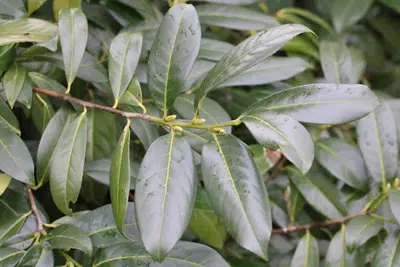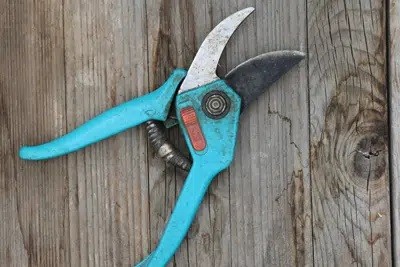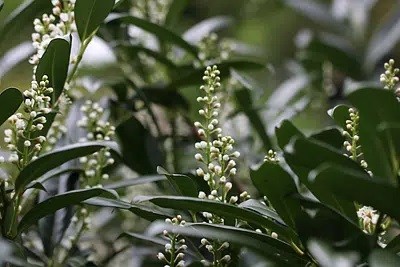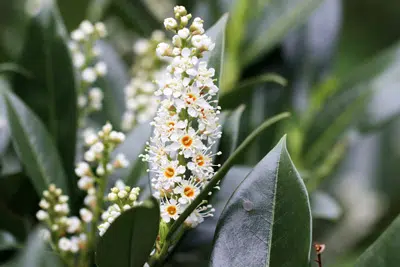Yellow leaves on cherry laurel are a fairly common occurrence, usually more of an annoyance than a real concern. Here you can learn how yellow leaves appear and when you need to do more than simply cut them off.
Contents
- 1 Wrong location or wrong soil?
- 2 The cherry laurel has not yet settled in.
- 3 The cherry laurel has sunburn
- 4 Is the watering of the cherry laurel correct?
- 5 Your cherry laurel needs fertilizer
- 6 Too much fertilizer
- 7 Too late fertilizer application
- 8 Incorrect pruning of the cherry laurel
- 9 Frost damage in winter
- 10 Drought damage
- 11 Is a disease of the cherry laurel to blame?
- 12 Conclusion
- 13 Author
Wrong location or wrong soil?
Actually, hardly conceivable, because cherry laurel can cope with both sunny and shady locations, but it does have a few requirements for the soil. If your just-planted cherry laurel starts to get yellow leaves, you should check whether you might have planted it in a soil that is too compacted or in a soil that is depleted – cherry laurel actually needs a fresh garden soil that should be quite deep.
If the soil is very compacted, you may be able to make the soil a little more “palatable” to your new cherry laurel by loosening it up with a digging fork (just poking it and moving it back and forth so you don’t damage any roots). Once the soil is drained, you should simply spread a good layer of mature compost on top of and next to the roots.
After that, you should give your cherry laurel some time, maybe it’s not the location or the soil anyway, but:
The cherry laurel has not yet settled in.
A freshly planted cherry laurel likes to react with yellow leaves, because every change of location is associated with great stress for a plant. The entire root area must first grow in, so it can happen that the cherry laurel does not have enough strength at the top to take care of it.
Once the cherry laurel has “taken root” (in the truest sense of the word), the problem with the yellow leaves usually takes care of itself.
The cherry laurel has sunburn
When freshly planted cherry laurel leaves can also turn yellowish, because he had to suffer from “sunburn”. This phenomenon occurs mainly in smaller young plants that have moved directly from greenhouse culture to the outdoors. In the greenhouses, these young plants have known little UV radiation, now outdoors the leaves react sensitively, similar to pale white human skin on a sunny South Sea beach. The plant needs a while to adapt here, then the yellow leaves disappear again.
Is the watering of the cherry laurel correct?
If the cherry laurel has been standing for a long time and only then gets yellow leaves, the next cause to check would be incorrect watering.
This can be some time ago, evergreen plants need a good quarter of a year until the first reactions can be seen in the leaves. It could be, for example, that you watered your cherry laurel overzealously after planting, and have long since stopped doing so, but the consequences of this “flooding” are only now becoming apparent. If from now on you leave the cherry laurel to be watered by the rain (which is quite sufficient except for unusually long dry periods), the problem with the yellow leaves should also grow out all by itself. By the way, cherry laurel does not like waterlogging either, which brings us back to the topic of loosening the soil.
The reason for the yellow leaves could also be a lack of watering, for example, if you left the cherry laurel to be watered by the rain too early. If so, it may not have developed enough fine roots to help with water uptake and had to suffer from bale dryness. This can also be quite a long time ago and will take at least as long to grow out. From now on, please water only the necessary amount more and resist the temptation to “spoil” the cherry laurel by overwatering – then you would end up directly one paragraph above.
Little help to estimate your past watering habits: sufficient watering under normal conditions means that each plant should get about 10 liters – a large bucket – of water per week and per meter of plant height.
Your cherry laurel needs fertilizer
If you fertilize your cherry laurel with slow-release fertilizer since it started to grow, it will grow fast, if you leave it, it will grow slower, both variants should not cause yellow leaves (unless you are trying to cultivate cherry laurel in sand, then you definitely need to add fertilizer).
Both variants should not cause yellow leaves – Unless you fertilize, but not with the mixture of nutrients that your cherry laurel needs. Then it starts to grow, but runs out of steam in the middle of its growth because it’s missing a particular nutrient.
The best fertilizer for cherry laurel is organic (slow-acting) and potash-based (promotes drought resistance and winter hardiness), applied twice a year. In addition, cherry laurels sometimes suffer from iron deficiency, which can be remedied, for example, with a special iron fertilizer or suitable stone meals.
Too much fertilizer
A cherry laurel will almost certainly react with yellow leaves if you lime right next to it (other plants or the lawn). It does not like a site that contains too much lime, and chlorosis (also known as “yellowing disease”) is inevitable.
If this has happened to you, the countermeasure is laborious: the entire soil around the plant must then be deeply loosened, it is best to add sand during loosening, which makes the soil more permeable to water and ensures that too much lime is washed away here. You can additionally apply acidic needle compost in the over-limed area, you could also replace the soil as is sometimes recommended.
If, however, the whole cherry laurel is not “glowing yellow”, but only a few leaves express their displeasure, you can probably do without actions with digging fork and sand, acidic compost and time will already help the cherry laurel on the jump.
Too late fertilizer application

Perhaps you meant too well and fertilized your cherry laurel through into the fall. However, it is better to refrain from fertilizing with quite a lot of nitrogen from late summer on, because with such fertilizer you once again stimulate the cherry laurel to strong vegetative growth. The shoots that are still produced at this time can then hardly lignify, which makes the cherry laurel much more susceptible to frost.
It should better prepare for winter dormancy at this time and allow the shoots developed in the first half of the season to mature so that they can withstand the winter cold well. You can help the cherry laurel do this with a potash fertilizer application in late summer, potash fertilizer helps the shoots mature and thus increases frost hardiness a bit.
Incorrect pruning of the cherry laurel

If the delinquent is a cherry laurel hedge, the miscoloration could be due to the wrong pruning (timing).
Cherry laurel hedges are best pruned before budbreak – if you leave it until the end of June (theoretically possible, cherry laurel only needs to be pruned once a year), all the new leaves will already be there. Now cut them quite often in the middle, this will give discolored leaves, at least if you use electric hedge clippers.
Think carefully before you act on the recommendation to cut later and avoid these leaf divisions and discoloration by trimming the hedge with hand garden shears. By this is meant that you should cut each branch individually, for normally busy people not even for 50 cm hedge a suitable method.
Frost damage in winter
The home of the cherry laurel is in Asia Minor, and there it is a little warmer than here. Cherry laurel is frost hardy in our country, but “only just so”, depending on the variety a little more or not so much. If you live in a harsh area of Europe, the first thing to do when buying is to make sure you buy one of the cherry laurel varieties that are really good frost hardy. However, when winter “really hits”, even these varieties might get too cold once in a while, especially with young plants, there are already occasional frostbite.
If it has become too cold for the cherry laurel, this can produce yellow or brownish leaves. This miscoloration develops mainly when, at the end of January or February, after an icy cold night, already noticeably warming rays of sunlight directly hit the leaves. Then the moisture in the leaves evaporates, but if the ground is still deeply frozen, the cherry laurel can not draw water through the roots, so it actually suffers from a lack of water rather than frostbite. If it is suddenly very cold but sunny in early spring, you could prevent damage of this kind by covering the cherry laurel with cloths to protect it from the effects of the sun’s rays. Certainly difficult for an entire cherry laurel hedge, but definitely an idea for a cherry laurel in a container, for example.
Drought damage

This miscoloration, which is actually drought damage, can develop during the winter even without too much cold for another reason: The cherry laurel is evergreen, which means that it will continue to need water even during its dormant growth period. If you were not aware of this yet, it happens quickly that you let your cherry laurel thirst during the winter, this also ends up in the development of yellow leaves.
Therefore, you should check the cherry laurel more often during the winter months for dryness in the root zone, and whenever the ground is not frozen, in case of doubt, water it a little. As a preventive measure against such drought damage, you could apply a thick layer of bark mulch in the fall, so the soil in the root zone will be spared from frost for a long time. However, even in this case, occasional watering is recommended, because the bark mulch, in turn, absorbs a large part of the rain, so less water can reach the roots.
Is a disease of the cherry laurel to blame?
If the leaves are not uniformly pale yellow throughout, but rather patchy yellow, bacterial leaf spot disease could be the culprit. The pathogen is called “Pseudomonas syringae pv. Syringae” and eventually causes holes in the leaves, but a pale yellow zone also develops around them first. The first measure here is pruning back to the healthy wood, then the disease is controlled.
If the leaves of the cherry laurel turn yellow and withered at the same time, the pathogen of shoot and lace drought could also be at work, a fungus called “Monilinia laxa”. It must be fought, otherwise the yellow leaves next get brown edges and / or spots, dry up completely and eventually fall off, usually followed by the whole branch. Against it helps only a strong pruning, which in any case should go quite a bit into the healthy wood.
Conclusion
If a cherry laurel gets yellow leaves, it is a reason to be vigilant, but not necessarily to panic. Most of the time, you just need to change your care habits a little and simply cut away the yellow leaves; only in rare cases is a serious disease of the cherry laurel the reason. Also, do not forget: the leaves of evergreen plants eventually grow old and are then shed, so a few yellow leaves are simply normal.


